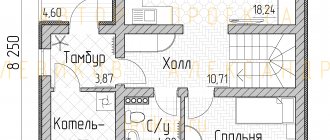Spelling a word
First of all, we need to determine the etymology of this apparently foreign word. Max Vasmer's Etymological Dictionary says it probably comes from the Latin prōiectus or prōiectum. There is no exact translation of this word, but the closest meaning is “predictable”. That is, it is clear that a project is something - an action or an object - that gives an idea of the result that needs to be obtained. You can also say that a project is a plan, a drawing of a future object.
One way or another, it is a noun of foreign origin. Meanwhile, we know that many foreign language nouns with a similar sound combination in the middle of the word - “OE”, “UE”, “AE” - are both heard and written with the letter E:
- poetry;
- poem;
- minuet;
- orthoepy;
- paella,
and others. It would seem that the word project should be written according to the same rule. But, as we know, in the Russian language the same rules do not apply everywhere. Therefore, although we hear the sound E in this noun, we write the letter E there: project.
This kind of word is not the only one; there are other exceptions, for example, “realtor”. It also sounds E, but is written E. Therefore, you just need to remember these words.
There are other borrowed words where E is heard at the end of the word, but E is written, as in the word project: “resume”, “macrame”. Perhaps this mnemonic device can help you remember:
A PROJECT MACRAME
I'll add it to my resume.
Of course, the cognate words “projected” and “designed” are also written with the vowel E.
However, as often happens in a living language, assimilation may occur over time, and these words, which are becoming increasingly common, will also be written the same way as they are heard. Perhaps this will happen soon, and questions about how to spell it correctly - project or project - will not arise.
Example sentences
- Pavel carefully folded the project of his future two-story brick house with a huge sauna and swimming pool and put it in a leather briefcase.
- The Ministry of Economy submitted the draft document to a general vote.
- The foreman triumphantly informed the entire team that the project had been signed, and tomorrow they could begin construction of a new high-rise in this residential area.
- The draft agreement was drawn up a long time ago; all that remains is for it to be somehow approved by the director of our branch.
- The project, containing text and drawings, was once again sent for revision.
SM PROJECT
11.22.2018 I think it’s fair to leave a negative review about the activities of the company SM-Repair (they are also “GK STROYMONTAZH”, “Trust Repair”, “FORTA Repair”, REMDOM 24, ART-DOM, DOMOSTROY 365, STANDARD REPAIR, SM PROJECT, etc. ).
This is how you get a multi-faceted aggregator that does not have its own teams, selects for you teams consisting of any and all with the goal of taking the maximum from you, and paying these same teams the minimum. Which, unfortunately, I had to verify from my own experience. So, I’ll start in order: it started with the estimate, which was drawn up in order to attract the client. It was clearly underestimated, thank God, I’m in the market and know the average price for various types of work and have a reasonable understanding of repair technology. After many leading questions, the estimator understood everything and was forced to redo the estimate, which increased exactly TWO times!!! With the new price, SM repair immediately reached the position of “slightly higher than the average market price”... Okay, I think, at least an honest estimate. The next surprise was that they offered to conclude an agreement with a certain LLC “Pobeda Repair”) - a company that has been on the market for a little over a year... Okay, I signed Contract No. 30097 dated May 28, 2018. Further more interesting. A meeting with foreman Denis Kravchenko - a lot of promises of quality work, Russian workers and a bright future and, as if in passing, the foreman asked why I didn’t want to do the repairs “privately” without the involvement of Pobeda Repair LLC... A week later the Russians started work , or rather, they did not start, but appeared at the site indicating the presence and “execution” of the Agreement. In fact, they were not going to work... Two days later, without warning, he showed up at the site and Oh, Miracle! Those same Russians are standing at the site (without changing into work uniforms) and watching how the two leftist Tajiks they brought to my site work! Tajiks, without covering the new radiators, putty on the walls along with the radiators! Then it’s even worse, all the people from the site disappeared, Denis Kravchenko did not appear at the site from the moment the “work” began and, without my knowledge, he handed over the keys to some abstract people who also had no intention of working and stole everything that fit in their bags ( the most expensive ones are brand new, in packaging, diamond bits for porcelain tiles, drill bits for concrete, etc.). In response to my call to the office demanding compensation, a bunch of promises were made and that was all... How the keys from foreman Denis Kravchenko got to completely left-handed people, he could not explain and stopped answering calls... The next foreman appointed by the office never showed up at the site, after which I received a call from the SM-Repair customer service and was told that there would be a new and super professional foreman, Alexander. After meeting with him, it became clear that he had neither specialized education nor work experience, nor, by the way, proven workers. Result: we “worked” for only a couple of days with the help of unsuitable Tajiks, stole the tools (the Slavs did this), pulled the tires without carrying out work for almost 2 weeks, replaced 3 foremen, admitted their own sloppiness and lack of professionalism!!! Conclusion: you saw an aggregator (without crews on staff) - drive them to the neck! Don’t waste your time, nerves, or money on unverified companies. Use teams based on recommendations from good friends and ask to see their work already done! Comment
Grammar
The grammatical characteristics of such a difficult-to-understand word as “project,” however, are simple. This is an inanimate noun of the masculine gender of the 2nd declension. Consists of one root. Placement of stress and the only transfer option project . But keep in mind: it is not recommended to move syllables beginning with a vowel to the bottom line; this greatly impairs the readability and intelligibility of the text. Case forms (singular/plural):
- Nominative: project/projects.
- Genitive: project/projects.
- Dative: project/projects.
- Accusative: project/projects.
- Creative: by project/projects.
- Prepositional: project/projects.
The derived adjective is “ project ”. Not “projective”! Specialists involved in design are designers, and organizations of the corresponding profile are designers.
What is a project? Definition and signs.
Published in 2013, Issue August 2013, SOCIOLOGY | 2 comments
Pak V.D.1, Nuzhina N.I.2
1Student, National Research Tomsk State University
2Student, National Research Tomsk State University
What is a project? Definition and signs.
annotation
.
The article analyzes the most common definitions of such terms as “project” and “project management”. The features of such a management object as a project are highlighted, and the content of these features is revealed.
Keywords:
project, project features.
Abstract
.
The article analyzes the most common definitions of terms such as “project” and “project management”. Marked characteristics of such an object as a project management and disclosed the content of these characteristics.
Keywords:
project, characteristics of project.
According to the Russian Association of Project Management "SOVNET", about 40% of targeted socially beneficial activities are implemented through various projects and programs and 25% of the world budget is spent on projects. Professional project management allows you to effectively distribute responsibilities and duties between project participants, save up to 30% of time and up to 20% of funds, and reduce the risks of project failure [2].
Another interesting statistic shows that participation in projects takes up from 30 to 70% of the working time of middle and senior managers [3].
“...organizations that are customer-oriented and forced to take into account their desires need a mechanism, a process that would allow them to successfully and quickly solve the problems they face. The project is intended to be such a mechanism. It serves as a kind of lens through which an organization or individual can “focus” resources and capabilities to achieve a set goal” [1].
In the activities of modern companies today, it is difficult not to notice the trend of transition from a traditional culture based on long-term planning to a World of Projects (Project World), in which business splits its activities into separate projects, allowing them to more quickly and flexibly meet market demands and survive in new conditions [4]. Business is always a good filter when selecting operating technologies, because if a particular technology is ineffective, it (the business) loses profit. The project approach has already been appreciated and is used by the world's leading companies such as IBM, Motorola, Boeing, Intel and many others. Such a widespread use of project activities in recent years is primarily due to the fact that the use of a project approach allows the most efficient use of available resources and achieving set goals within the required time frame. This is precisely the reason for the proliferation of projects, noted by one of the most authoritative experts in the field of project management, Phil Bagyuley: “... we have begun to better understand the importance of projects, because they not only allow us to create something new, but also use our resources most effectively” [1].
It becomes quite obvious that project management competence is one of the key ones in the activities of modern organizations.
What is a “project”?
In modern literature and the Internet you can find an infinite number of definitions of these terms, but they are all quite similar, so we will focus on a few of them.
- PMBoK
:
A project is a temporary undertaking designed to create unique products, services or results [6].
- English Association of Project Managers:
A project is a separate enterprise with specific goals, often including requirements for time, cost and quality of results achieved [6].
- Germany, DIN 69901 standard:
A project is an enterprise (intention), which is largely characterized by the uniqueness of the conditions in their totality, for example: setting a goal; time, financial, human and other restrictions; distinctions from other intentions; project-specific organization of its implementation [6].
- Phil Bagewley
A project is a sequence of interrelated events that occur over a specified limited period of time and are aimed at achieving a unique, but at the same time, specific result [1].
- A. G. Ivasenko, Ya. I. Nikonova, M. V. Karkavin
A project is a time-limited, purposeful change to a separate system with initially clearly defined goals, the achievement of which determines the completion of the project, with established requirements for timing, results, risk, framework for spending funds and resources, and for the organizational structure [3].
- V. N. Funtov
A project is a purposeful, time-limited activity carried out to meet specific needs in the presence of external and internal restrictions and the use of limited resources [5].
As we can see, the definitions are indeed very similar. In all definitions, the authors talk about some features inherent in all projects without exception - we are talking about the so-called project features. Let's highlight these signs.
The presence of a specific, clearly defined goal (for Beguli - a result).
Goal setting is the first and initial stage of the project. It can be quite difficult to correctly define a goal, however, it is extremely important that the goal is set and indicators for achieving it are defined. Any project, the smallest or the largest, is conceived to achieve some result. “All projects have very definite results. It could be a new house, a printed book, a modified company structure, a new car purchased, or an election victory" [1]. Therefore, if a project does not have a specific goal, it cannot be a project. Both Pounds and Beguli note that achieving the main goal of a project often occurs by achieving intermediate goals, which also need to be determined and planned in advance. In this case, the project will end after all intermediate goals have been achieved.
Each project is unique.
No two projects are alike.
Each project differs from the other at least in time, not in time, but in place. Of course, there are projects whose uniqueness is obvious, for example, the Cheops Pyramid in Giza mentioned at the beginning, and there are projects that are not so unique. On this basis, we can distinguish standard
projects with little signs of uniqueness and
atypical
, one-time projects with high uniqueness [5]. It should also be noted that uniqueness can be attributed to both the project as a whole and its individual components. For example, the project of a human flight to Mars is unique in itself - no one has ever done this, but the construction of a new house is not such a unique project, but the technology by which it was built, or the new materials used in construction may be unique.
One-time nature
What distinguishes projects from business processes is that no repeating activity can be considered a project. The project is developed, implemented, completed – that’s it. If there is a return to the same activities that took place during the implementation of the project, then perhaps it was not a project. It is important to understand that activities may be repeated during the course of a project. This will happen if a person is working on a project to publish his book, he will have to return to writing this book for a certain amount of time every day until the work is completed.
Time limitation of the project
means that any project has a definite beginning and end. A project may last several days or weeks, or perhaps several years or even decades, however, even in such projects there is a deadline. Completion of a project is usually associated with the achievement of the project goal, or completion can be said when it turns out that the project goal cannot be achieved in any way. It is worth saying that different projects can either have a fixed beginning, in which case planning of the project is carried out from its beginning, or a fixed end, then, accordingly, planning begins from the end.
Limited resources.
This sign indicates that each project has, first of all, a certain budget allocated to it, and the project must be implemented within the framework of this budget. In addition, the project also has limited human resources and other material and technical resources.
To summarize all of the above, we note that, knowing the signs of such a phenomenon as a project, a modern manager will be able to more effectively organize project management work in his organization.
Literature
1) Beguli F. Project management: trans. from English / F. Beguli - M.: Grand FAIR PRESS, 2002. - 202 p.
2) Voropaev V. Project management? Unused resource in the Russian economy [Electronic resource] / V. Voropaev // Portal “iTeam. Technologies of corporate governance” – Electron. Dan. – [B. m.], 2002-2013. – URL: https://www.iteam.ru/publications/project/section_35/article_1635/ (access date: 04/19/13)
3) Ivasenko A. G. Project management / A. G. Ivasenko, Ya. I. Nikonova, M. V. Karkavin - Rostov-on-Don: Phoenix, 2009. - 327 p.
4) Martin P., Tate K. Project management: trans. from English / P. Martin, K. Tate – St. Petersburg: Peter, 2006. – 224 p.
5) Pounds V.N. Fundamentals of project management in a company. / V. N. Funtov – St. Petersburg: Peter, 2011. – 393 p.
6) What is a “project”? // [Email resource] – https://www.pandia.ru/365896/ (access date: 06.28.2013)
Design methods
The choice of design method depends on the purpose of the project.
It is customary to classify several methods. Let's look at them in a little more detail.
- Waterfall method : all design stages are performed one after another (i.e. linearly): study of initial conditions;
- creation of the main project;
- project detailing (development of subprojects);
- implementation of subprojects;
- project verification.
design → implementation → analysis → adjustment
This planning method allows you to minimize the consequences of possible project flaws.
Project classification
The division of projects into types and types depends on the classifying characteristics. Let's look at the classification in the summary table:
| Classifying feature | Project type |
| field of activity |
|
| structure |
|
| duration |
|
| scale |
|
| degree of difficulty |
|
| nature of the project |
|
Source of errors
The reason for the errors in our case is to think of the International Phonetic Alphabet (IPA). It was developed at the end of the 19th century. in England for the convenience of managing the then huge British Empire. It was not possible to colonize the Slavs, even the industrially backward and economically weak Bosniaks, Lusatian Serbs, Slovenes, Montenegrins, and Kosovars: the then leaders of Great Britain were anything but fools. Therefore, when creating the IPA, the features of Slavic pronunciation were taken into account last. As a result, the IPA gives the following reading of “project” : [prɐˈɛkt]. According to the IPA rules, the stressed [ˈɛ] is read almost like the Russian “e”. It would be more correct to indicate [prɐˈəkt], but the sound [ˈə] is not provided in the IPA: the stressed “é” in it is designated [ˈe]. And in Russian there is no sound corresponding to [ˈɛ]; our stress after the vowel “e” is pronounced somewhat harder and clearer.
As a result, listening to the Wiktionary speaker, or doing it on your own, the reader’s subconscious mind is stuck with the incorrect pronunciation of the word “project.” And from here it’s not far from making a mistake in writing: who, when writing or typing the next letter, would begin to go over the school letter in their mind? You won’t be able to write anything like that forever. For comparison: flight school cadets who by the 3rd year have not learned to fly intuitively, at least in a straight line, are expelled. Even if their health and psyche are otherwise ideal.









